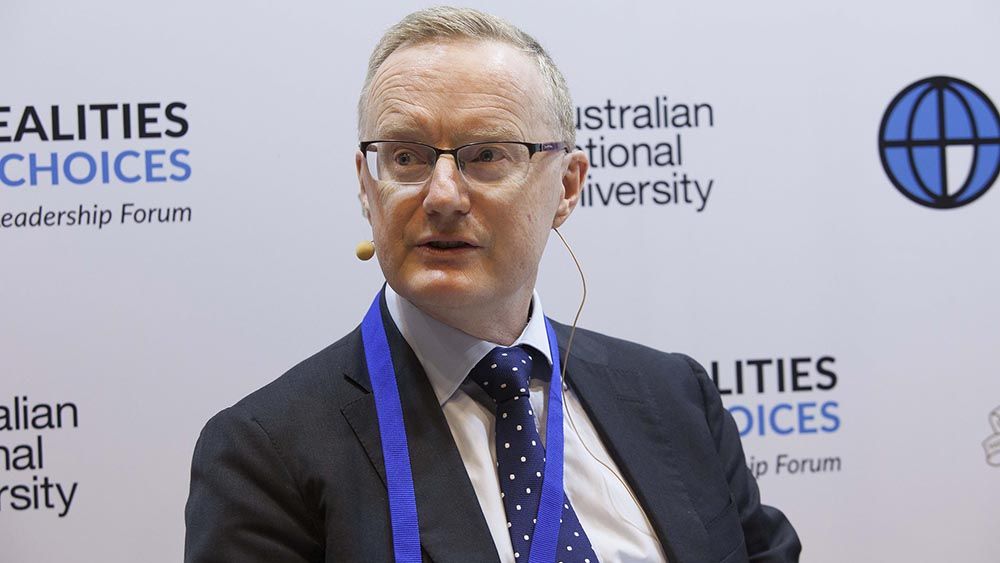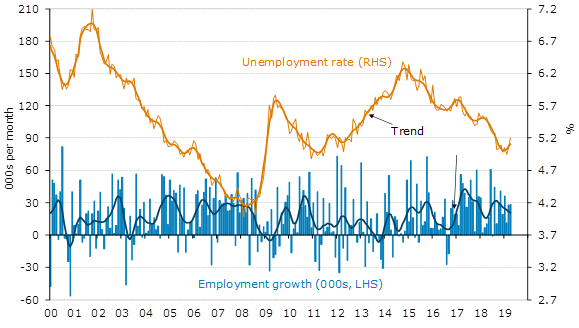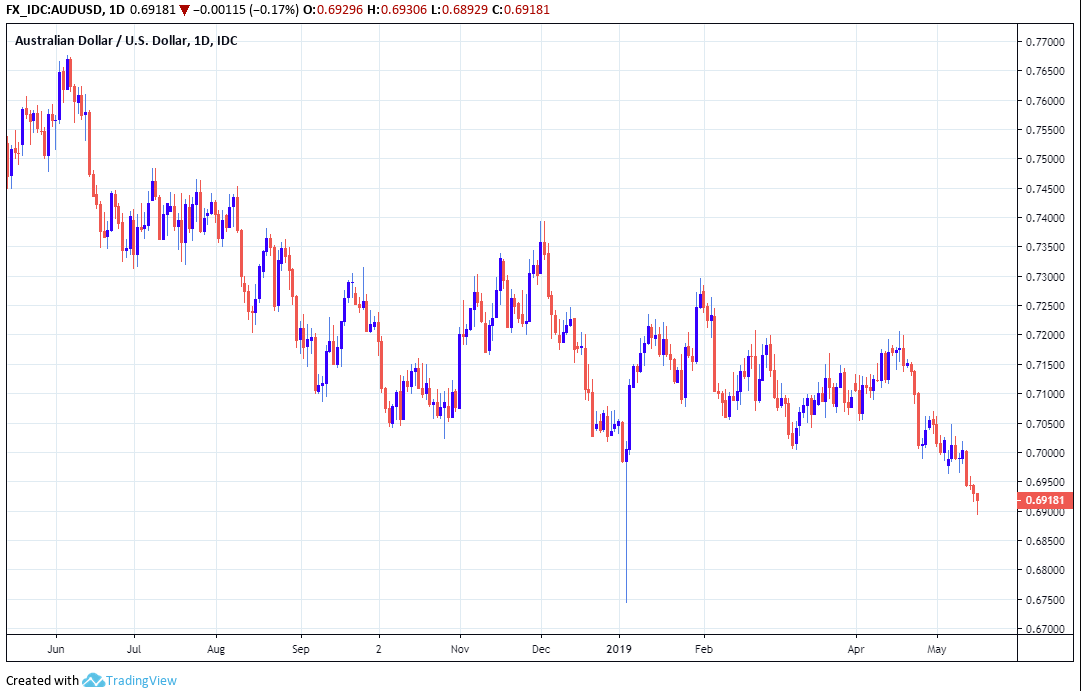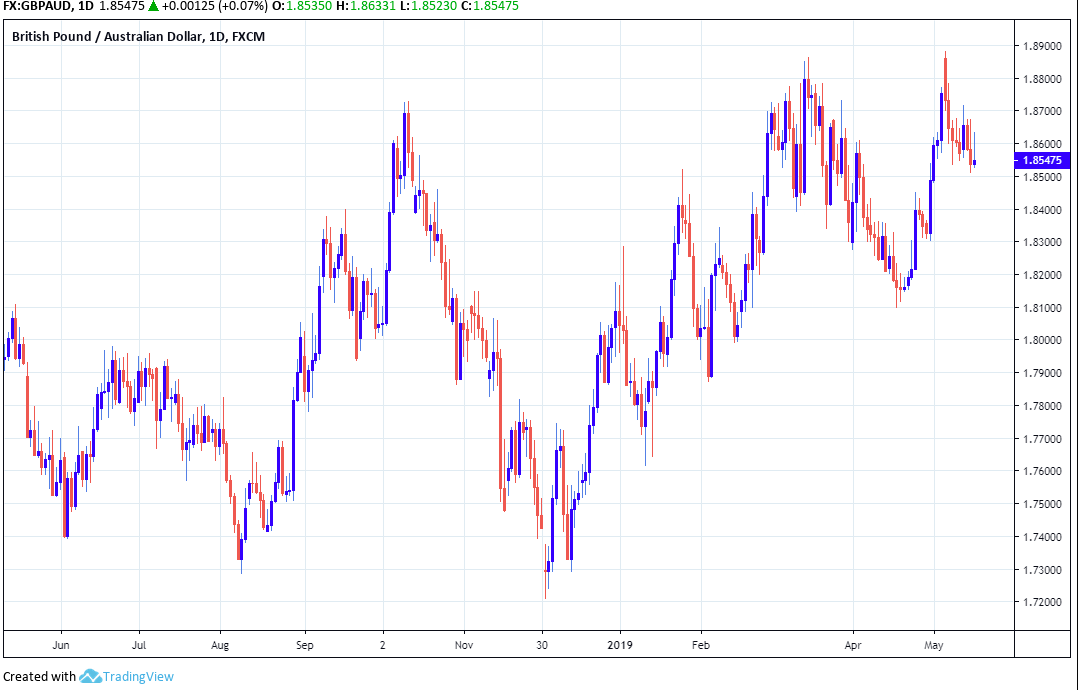Australian Dollar to Remain Under Pressure after Unemployment Spike Gives RBA Green Light for June Rate Cut
- Written by: James Skinner

Image © Crawford Forum, Reproduced Under CC Licensing
- AUD slips further after jobless numbers argue for June RBA cut.
- Inflation target seen slipping from view, market eyes RBA minutes.
- U.S.-China trade news another headwind, market to shun AUD.
The Australian Dollar was on its back foot again Thursday after April's jobs figures gave what some say is a green light for the Reserve Bank of Australia (RBA) to cut its interest rate as soon as June.
Australian Bureau of Statistics data shows the economy created 28.2k new jobs during April when markets had looked for an increase of only 15.2k, but all of the jobs created were within the part-time category and so are less of a positive factor than would otherwise have been the case.
Full-time employment actually fell by just -6.2k last month while the number of part-time workers rose 34.7k. Furthermore, then unemployment rate posted a surprise 20 basis point increase to 5.2%.
This means Australian unemployment has now risen 0.3% since February which, incidentally, was the month when the Reserve Bank of Australia told markets that a sustained increase in joblessness this year would be enough to force it into cutting Aussie interest rates.
"The increased slack in the labour market will not help progress towards its inflation target. Coupled with the soft employment component of Tuesday’s NAB survey, a June rate cut must be a distinct possibility. We will wait until we see what the RBA Governor has to say on Tuesday before we make a call," says Catherine Birch, an economist at Australia & New Zealand Banking Group.
The AUD/USD rate was quoted -0.18% lower at 0.6913 during the morning session Thursday and is now down -1.9% for 2019, while the Pound-to-Australian-Dollar rate was 0.04% higher at 1.8554 and has risen 2.5% this year.

Above: Australian jobs growth and the unemployment rate. Source: ANZ Research.
Markets care about unemployment figures because it takes a healthy labour market for workers to be able to demand improved pay packets, and the RBA has said the economy needs to produce wage growth of around 3% per year if inflation is ever to sustainably rise and hold within the 2%-to-3% target band.
Australian Bureau of Statistics data showed on Wednesday that wages grew by 0.5% in the first quarter of 2019, unchanged from the final quarter of 2018 and below the 0.6% increase that markets had been looking for. The annual pace of wage growth held steady at 2.3%.
"The Australia dollar has been one of the worst performing currencies overnight resulting in the AUD/USD rate falling to a new low of 0.6893. It is moving closer to the “flash crash” low from the start of this year set at 0.6741," says Lee Hardman, a currency analyst at MUFG. "The recent rise in the unemployment rate is putting pressure on the RBA to cut rates. In these circumstances, we expect the Aussie to remain under selling pressure in the near-term."
The RBA cannot raise its interest rate until the consumer price index is sustainably above 2%, which it hasn't been for a number of years. Without higher domestic interest rates the Australian Dollar could remain under pressure on currency markets until other central banks cut their own rates.
And if the RBA happens to cut rates, as currency markets think that it will sooner or later, then the Australian Dollar could find itself plumbing new lows against many of its rivals as the bond yield advantage it enjoys over other currencies is further eroded.
Interest rate decisions influence international capital flows, which tend to move in the direction of the most advantageous or improving relative-returns, and are a lure for short-term speculators.

Above: AUD/USD rate shown at daily intervals.
"There is a strong chance that the RBA will announce a rate cut at its next policy meeting on June 4. We see risk that this would enhance the downtrend in AUD/USD towards 0.68 on a 6 month view," says Jane Foley at Rabobank.
The RBA has blown hot and cold on the rate interest rate outlook since February, and signalled in its May policy statement that it has come no closer to cutting its interest rate. But financial markets are still betting heavily that Aussie borrowing costs will hit a new record low this year.
Economists are now waiting on the release of minutes from the latest RBA meeting for clues as to how accurate their reading of the recent message was. The minutes will be released at 02:30 on May 21.
Pricing in the overnight-index-swap market implied on Thursday an RBA cash rate of 1.33% for June 04, which is far below the current 1.5% level and half way toward the 1.25% that would prevail if the bank did cut rates.
The implied rate for August 06, which is when most analysts see a rate cut coming, was 1.14% while the rate for November was just 0.98%. This means markets have fully priced-in two RBA cuts for 2019 and then some.
"The current Bloomberg survey of Australian economists shows a rate cut by the RBA is not expected until Q3 2019. By contrast, the futures markets is pricing a 63% chance of a rate cut in June 2019 and two rate cuts by November 2019," says Joseph Capurso at Commonwealth Bank of Australia. "If the RBA were to cut the cash rate sooner, say in June 2019, history suggests AUD/USD could drop by around 0.7% 30 minutes after the RBA decision. Just to be clear, the CBA house view is the RBA will remain on the sidelines."

Above: Pound-to-Australian-Dollar rate shown at daily intervals.
"China’s economy made a softer than expected start to Q2 with fixed asset investment, industrial production and retail sales all coming in weaker than expected. It has put a dampener of optimism that China’s economy is stabilizing in response to policy stimulus. Indeed, China’s economy appears to have been losing momentum again even prior to the negative shock from the US tariff hike announcement," writes MUFG's Hardman, in a note to clients.
The Australian Dollar is widely expected to remain under pressure so long as financial markets are betting on RBA rate cuts, but that's not the only headwind plaguing the Antipodean currency because the trade war between the U.S. and China has stepped up a gear in recent weeks.
The White House has lifted from 10% to 25% the tariff levied on around $200 bn of annual imports from China and set the ball rolling on a process that could see a 25% tariff imposed on China's remaining $300 bn of exports to the U.S.
China has since retaliated by lifting to 25% the tariff levied from around $60 bn of annual imports from the U.S., and rhetoric from both the U.S. and Chinese governments toward one another is turning increasingly hostile, stoking fears of a protracted trade conflict.
This matters for the Aussie because the currency is underwritten to a substantial extent by a gigantic commodity trade with China, which might suffer indirectly if the conflict between the world's two largest economies gets out of hand.
Such a thing would be certain to damage the outlook for global economic growth, hitting commodity prices in the process and reducing the value of Australia's export trade with China.
"US President Trump has signed an executive order banning Huawei from being used on national security grounds, or from buying components from US suppliers, meaning what was already true for the public sector now applies to the private sector too. Does this take us even closer to a US-China trade deal? That Huawei news is not going to be welcome in Asia given the shocking data backdrop. Chinese numbers were horrible on all fronts," writes Michael Every, a strategist at Rabobank.
"
Time to move your money? Get 3-5% more currency than your bank would offer by using the services of foreign exchange specialists at RationalFX. A specialist broker can deliver you an exchange rate closer to the real market rate, thereby saving you substantial quantities of currency. Find out more here.
* Advertisement




